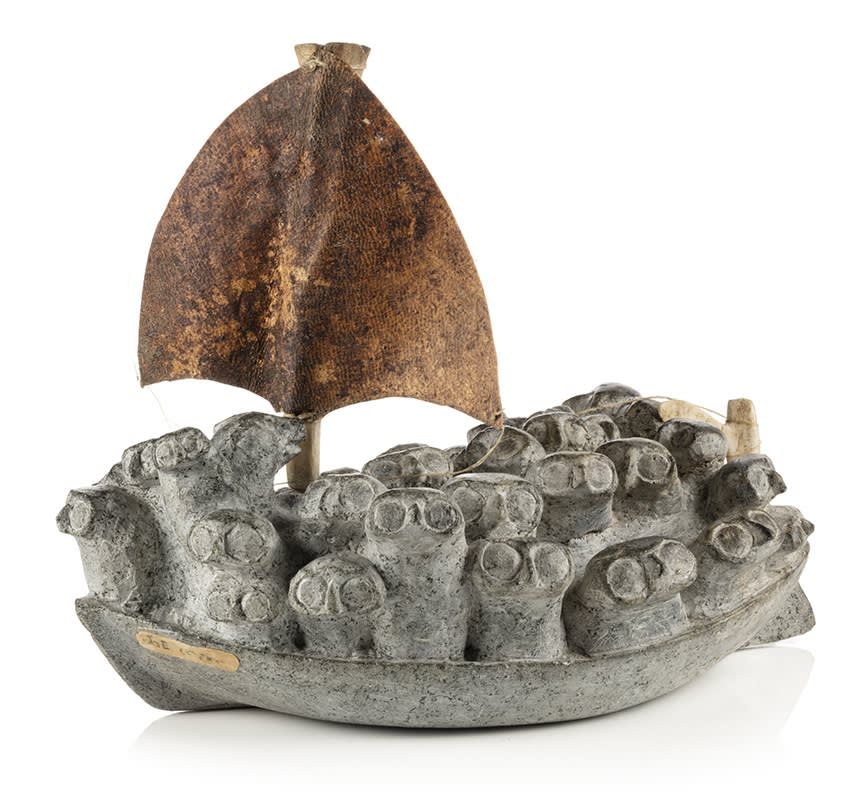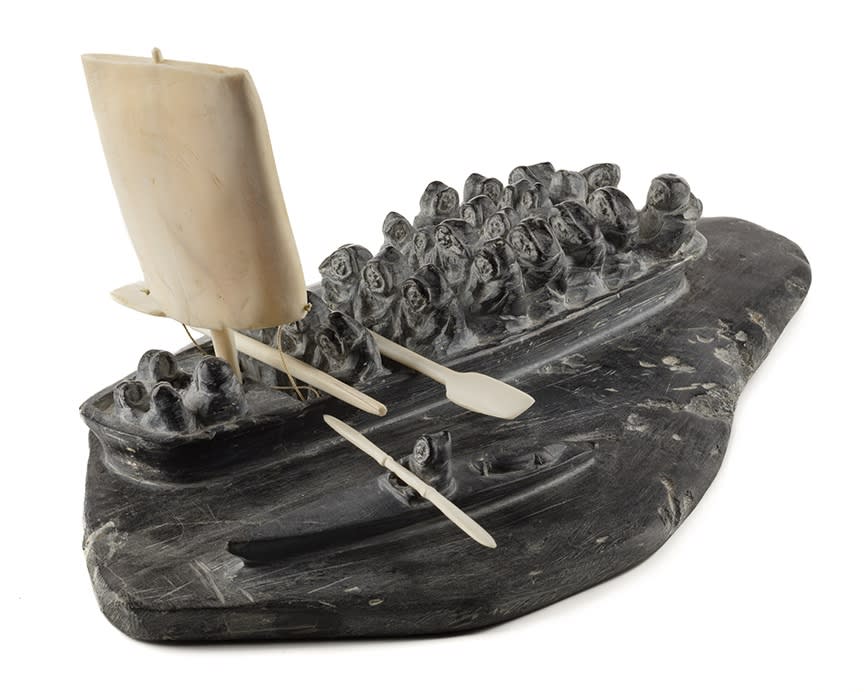Few works of Inuit art have captured the imaginations of Inuit art collectors in the way that Joe Talirunili’s Migration Boats have. They speak to the indomitable spirit and resourcefulness of Inuit in general, even in times of disaster and peril, but also specifically to the whimsical and adventurous folk-art spirit of their maker. “Joe” as he is so often simply known as, also embodies the popular image of the slightly cheeky and rebellious free-spirited artist. Not much appreciated by his Puvirnituq peers, Joe Talirunili nonetheless became Nunavik’s most beloved artist in “Southern” art circles.
The two subjects that Joe favoured in the last dozen years of his remarkable career are also the ones he is most famous for: his Migration Boats, and his Owls. Migration Boat with Owls and Dog is an extraordinary sculpture that is absolutely unique in this artist’s oeuvre, being the only work that combines these two themes. The story behind the making of this gem is as charming as the work itself.
Arden Barnes, an intrepid American nurse anaesthetist, travelled to Churchill, Manitoba in 1960 to experience the northern lands her father had worked in as a Hudson’s Bay fur trader in the early 1900s. Intrigued by a Puvirnituq carving she had purchased there, she flew to Puvirnituq in 1961 and spent the first of what would be nine summers in the Arctic Québec community. She became Joe’s neighbour and close friend, having purchased his old plywood doghouse, and “renovated” it as her living quarters! Barnes fell in love with Joe’s carvings and purchased many from him over the years. She loved his Owls in particular. One day a beaming Talirunili (who by then had become famous for his Migration Boats) arrived at Barnes’s “house” with a boat full of owls (and one dog) for her! (She loved dogs and had in fact received a husky puppy belonging to Talirunili’s cousin Davidialuk, which she raised back home in Minnesota.) Barnes treasured the sculpture and the rest of her collection for over thirty years, before finally selling it in 1999. At the time, this sculpture fetched a world-record price at auction for a work of Inuit art!

Lot 37
JOE TALIRUNILI (1893-1976) PUVIRNITUQ (POVUNGNITUK)
Migration Boat with Owls and Dog, c. 1966-67
ESTIMATE: $250,000 — $350,000
Migration Boat with Owls and Dog was probably carved c. 1966-67, a couple of years after Talirunili’s very first Migration Boat from 1964. The sculpture is beautifully executed and brimming with lively and incredibly charming owls – which is not surprising, since Joe carved it with a very special client-friend in mind. To say that this boat brims with owls is an understatement; it is fairly bursting with them; there is room for only one to slightly spread its wings. Very few of the owls look forwards; rather they all face outwards, as if straining to look back at us, the viewers; some even gaze upwards. Their eyes are huge, quite mesmerizingly so, and seemingly filled with wonder. The lone dog looks back, its mouth open in an excited bark. The psychological effect on the viewer is quite different from that of a “typical” Migration Boat by Talirunili, but it is no less powerful. Rather than conveying urgency and fear, Migration Boat with Owls and Dog expresses joie de vivre, wonderment, and the quirky exuberance that we associate with its maker. Given Joe’s obsessive fascination with owls, it is not a stretch to imagine that he truly identified with them. So, although this sculpture might not be autobiographical, it certainly feels revelatory.
Migration Boat with Owls and Dog does share several key attributes with other boats by the artist – with a couple of interesting twists. The mast appears to be made of bone (or possibly antler), which is a highly unusual departure. The skin sail also is of an unusual shape, and we wonder if it’s deliberately meant to look wing-like. The boat’s stone rudder, carved as an extension of the boat’s stern, is beautifully shaped, while the antler tiller nicely echoes the organic form of the mast. And Joe has affixed a paper label to the front of the hull bearing his signature in Roman letters and Inuktitut syllabics. We at First Arts are proud and excited to be able to find a new home for this extraordinary work of art.

We are doubly proud to have the opportunity to showcase another truly remarkable Migration sculpture by Ennutsiak, the most famous elder artist from Iqaluit (formerly known as Frobisher Bay). Interestingly, Ennutsiak and Talirunili were almost exact contemporaries; both were born in the 1890s and both died in 1976. Ennutsiak was also born in Nunavik (Arctic Québec), but his life story is quite different from Joe’s. Ennutsiaq was part of a migration to southern Baffin Island early in his life. The ocean voyage across Hudson Strait (well over 100 kilometres) would have been a major undertaking, consisting of several families crowded into an umiaq, likely accompanied by a small flotilla of kayaks. Ennutsiak lived for many years in the Lake Harbour area and moved to Frobisher Bay probably in the mid 1940s. He began carving as early as 1950, selling mainly to a local market that included American servicemen and people constructing NORAD’s DEW Line at the height of the Cold War. Ennutsiak is best known for his tableau-style scenes depicting birthing, hunting, flensing marine mammals, travelling on the land and even bible reading – all communal activities. His Umiaq Migrations are large and ambitious but quite rare; our example is the largest and most complex example we know of.
Ennutsiak adopted a rustic, realistic carving style that we have often compared with a folk-art sensibility of Talirunili. Umiaq Migration with Kayaker actually predates Joe’s earliest version by several years, but we have no evidence that either artist knew of the other’s work. This wonderful sculpture depicts a voyage that was more organized than the typical Migrations depicted by Joe, though the voyage itself may have been just as perilous. Talirunili’s Migrations usually depict a harrowing tale of adventure with his characteristic expressionism. Ennutsiak’s Umiaq Migration with Kayaker describes what would have also been a life-changing event for the young man. It’s a masterpiece lovingly executed by one of Inuit art’s great and well-loved elder artists.

Lot 52
ENNUTSIAK (1893-1976) IQALUIT (FROBISHER BAY)
Umiak Migration with Kayaker, c. 1960
ESTIMATE: $35,000 — $50,000
In Umiaq Migration with Kayaker Ennutsiak illustrates the classic Nunavik shape and construction of the large communal boat (which can be clearly seen in two old photos reproduced in Marybelle Myers’ book on Joe Talirunili, FCNQ, 1977). We should remember that Ennutsiak’s community had the time to build and outfit a proper boat for their migration voyage, while the boat in Talirunili’s adventure was jerry-built in an emergency. Ennutsiak’s long, rectangular craft is powered by oars and a sail, and is fitted with a rudder – all carefully carved from ivory. What makes this version even more exceptional is the addition of the kayaker who paddles alongside the umiaq, and the fact that Ennutsiaq has turned the scene into a maritime tableau; astonishingly, the umiaq (and its passengers), the kayaker, and the “ocean” are all carved from a single piece of stone.

Both Joe Talirunili’s Migration Boat with Owls and Dog and Ennutsiak’s Umiaq Migration with Kayaker are outstanding works of art, beautifully executed and exceptionally rare. We are certain that Joe and Ennutsiak never met, but just imagine if they had – the stories and jokes they could have shared! We are so pleased to be able to bring their two masterpieces together for one last time, before they sail away to their new homes.
